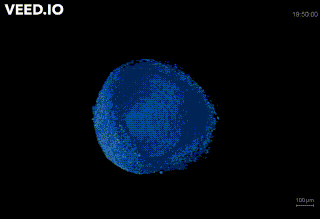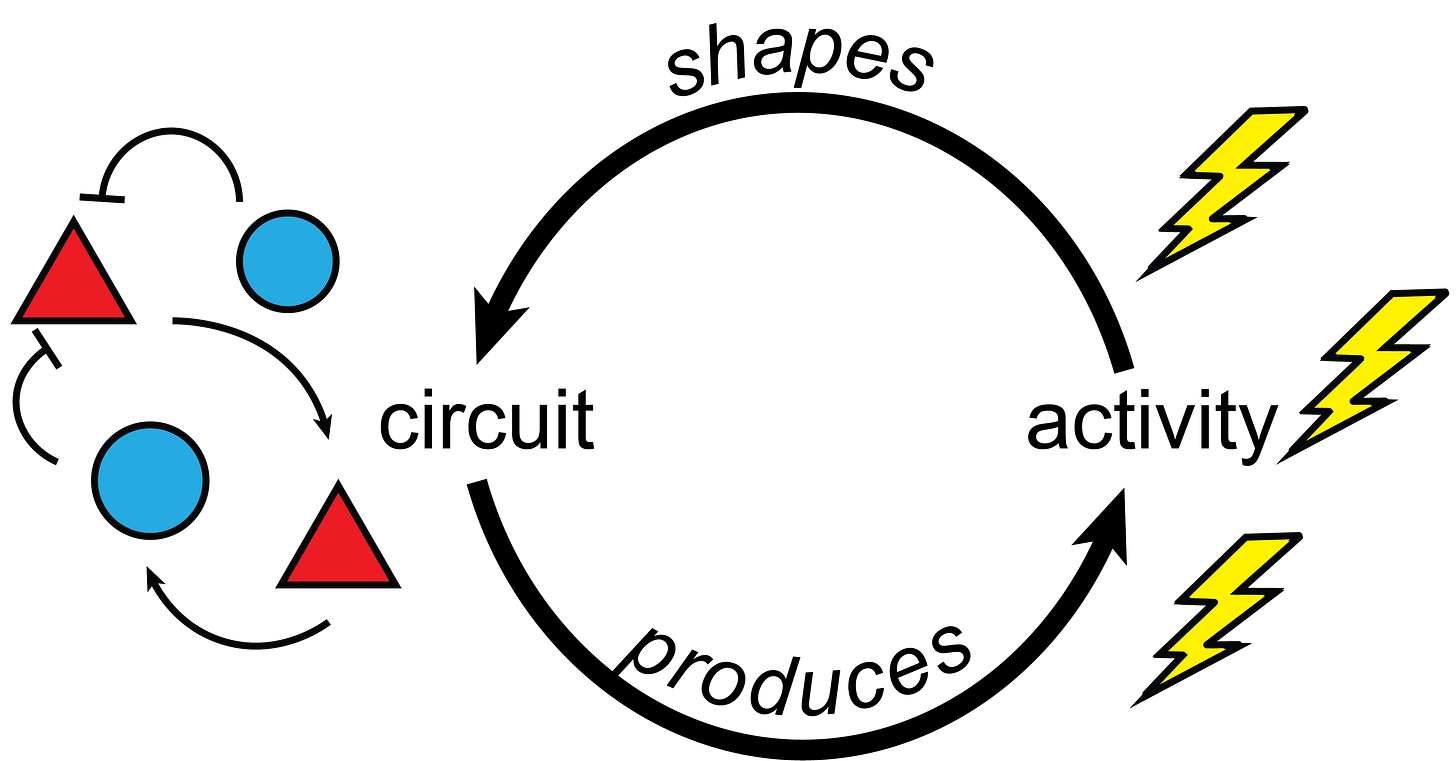How to build a mind - neuroscience edition
TL;DR: The early development of the brain, from molecular biology via dynamical systems to the theory of computation. Some speculation about how everything fits together.
Apologia
There is a story about John Nash that I like a lot. John Nash is a famous mathematician who got a (fake) Nobel prize for his work in game theory as well as a Hollywood adaptation starring Russell Crowe. But (if you trust his biography) his contribution to mathematics is at least as great. He had a very curious way of working:
Nash's main mode of picking up information he deemed necessary consisted of quizzing various faculty members and fellow students. [...] Some of his best ideas came "from things learned only halfway, sometimes even wrongly, and trying to reconstruct them - even if he could not do so completely. (A Beautiful Mind, Sylvia Nasar, pg 68)
He started out with something very wrong, then went with his first (wrong) attempt at a solution to one of his colleagues, who helped make it slightly less wrong. Nash then repeated this procedure until, in the end, he had a working proof.
Apart from some hard questions about ownership (can Nash really claim that he produced the proof?) and the obvious issue that Nash turned very schizophrenic in his later years, I admire this way of working (at least for doing very hard research) and aspire to do the same. I really really want to get answers - and I don't care if I have to recruit help and produce a lot of nonsense on the way. This is, of course, just a poor fig leave of a defense for all the nonsense I am producing on this platform. Mea culpa.1
Several perspectives on development
After building a digital person, writing love letters to albatrosses, philosophizing about scale in academia, and asking large language models pointed questions, it is time to write about something where I actually have institutional credentials, i.e. neuroscience and the development of the brain. Why is this an interesting topic?2 While traditionally brain development is a very biology-heavy topic, there are some beautiful results and ideas that generalize far beyond biology and become relevant for people working on artificial intelligence or computations in general. And those results are not widely known, especially not outside a small community in (computational) neuroscience. This essay is written with this in mind and I have tried to reduce jargon to a minimum.
The biology info in this post is focused on small mammals (mouse pups), which might feel like a limitation3. But then again, mice can do a lot more than you’d think. Exhibit 1 - skateboard mouse!

A “pretty pictures” perspective
I would not call myself a biologist by any stretch of the imagination - but I can get very excited about videos. Seeing biology in action is very cool.
Embryonic Day 1: Here is a recording of a mouse embryo at the "two-cell stage".

Embryonic Day 6-8: From there, things get out of hand quickly. Cells just keep on dividing.

It's not super easy to see, but inside that ball of cells is a sheet of cells that folds into a tube (appropriately named the neural tube) that will eventually develop into the central nervous system (i.e. brain and spinal cord).
Embryonic Day 11: And then we're basically there. Just add a few tiny paws, mouth, eyes, tail, all the good stuff.
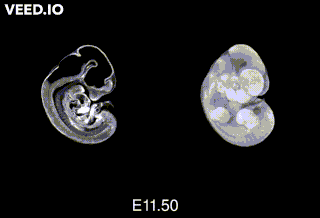
Embryonic day 20/Postnatal day 1: The mouse pup is born! But at that point, the pup is still “extremely-not-ready” for the world. "Day 1" here is the first day after birth.

Postnatal day 10: While there is a lot happening "on the inside", not so much is showing on the outside. We still only have a pile of adorable mouse pups.
Postnatal day 25: But fast-forward 15 more days and it's like day and night - the mice (not pups anymore) are basically ready to go! Around postnatal day 14, they open their eyes, grow hair, and start running around.
There is still a lot more that happens after this stage (the brain keeps changing throughout the entire lifetime), but these first 2-3 weeks set up a lot of the central nervous system.
It is great how visual this part of biology is. I hope you found those videos as enjoyable as I did. It's very important to get a feel for what you are talking about, otherwise, you might miss what's in plain sight. In the end, all models and theories cash out to a handful of cells or a pile of mouse pups. Everything is very messy.
A molecular biology perspective
Okay, that’s what development looks like. How does it work? Let's zoom in a bit further. Those first cells in the clip at the top contain the entire genetic code. Can we understand that? How does it instruct the cells to divide like that and to form that ball and the pile of pups and do all the other things? Those are reasonable questions, right?
Well, take this as an answer:
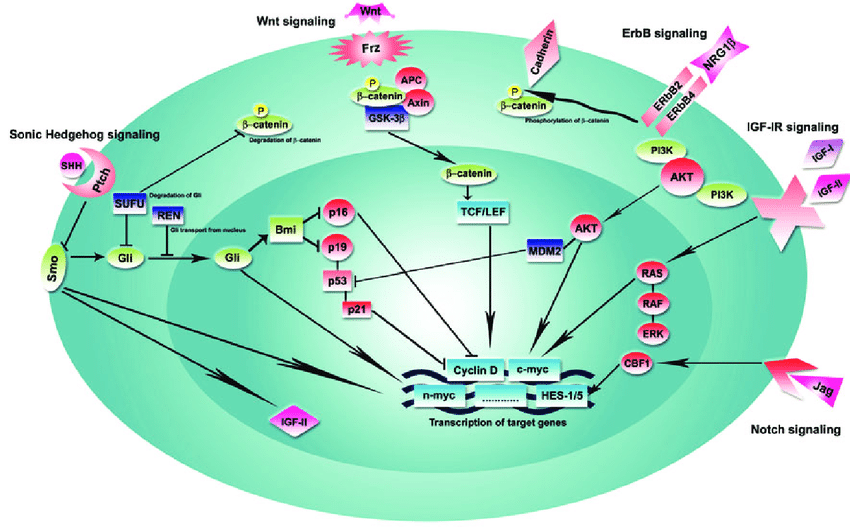
That's a lot to take in and if you make the mistake of asking an expert about it, you will learn 1000 interesting facts about "Bmi inhibition of p19" before lunchtime. Luckily I am not an expert on molecular biology, so I will give you just the most high-level explanation of how development happens on the molecular level:
The behavior of a cell is determined by the proteins it expresses. The "central dogma" of molecular biology says that "DNA makes RNA, and RNA makes protein", so proteins come from the genes. Since we want a lot of different cells that do different things, we need cells with different proteins. "Signaling pathways" (like Sonic Hedgehog, Wnt, ErbB, IGF-IR, and Notch) can tell the cell which genes to express and, therefore, which protein to express. How does the brain know which signals to send to which cell? It just makes sure that different signalling molecules end up in different parts of the developing brain.
All of this is, like, really complicated, but we4 are making good headway in improving our understanding. And perhaps there is hope that things will get easier to understand when we know more. Perhaps everything will just beautifully fall into place. But also perhaps not:
There is no rule that says nature can not be more complex than our brains can handle. And after billions of years of evolution, why should it be simple?
Perhaps there are no shortcuts in explaining how the brain develops. Perhaps there are no simple sub-modules that can be carved out, studied in isolation, and reduced. That would be kind of annoying.
A computational perspective
But explanations in terms of genes feel very unsatisfactory anyway. If I ask "How does a computer work?" it is not technically wrong to give me an explanation of the chip-making procedure.5 But what I actually want to hear is an explanation of boolean circuits and perhaps a bit on the theory of computation. It's not actually very useful to understand exactly how a microprocessor works at the transistor level - but the theory of computation has legs in terms of what it can explain. So are there statements about brain development that are flavored a bit more like the theory of computation?
Despite the (somewhat fatalistic) arguments about the possible futility of understanding biology, there are also good reasons to believe that we can get nice & simple answers. The implicit assumption that runs through the "gene-centered" perspective outlined in the previous section is that "the genes execute a (complicated) program that eventually produces a functional body+brain. To understand that process, we have to completely reverse-engineer the genetic program.” But as we have seen in the videos, a newly born mouse experiences a lot of development after birth, at which point the animal is already exposed to its environment.
How exactly does that make it better? Doesn't that just make it... even more complicated? Indeed, the environment can be very hard to predict and quite perturbative: predators, conspecifics, seasons, losing an eye or a limb, the list goes on and on. It would be very hard to come up with individually tailored solutions to compensate for all of the possible perturbations. And weirdly enough that's a silver lining! In these situations, where the system is constantly perturbed and has to solve a lot of different problems, general solutions emerge (often). These general solutions tend to be not too complicated and they tend to work well even outside the training domain.6 And they are one thing above all: robust to perturbations.7
A dynamical system perspective
How do you get robustness? There is a standard answer from control theory that generalizes: Tightly coupled feedback loops. And indeed there is a very natural candidate for implementing such a loop: the reciprocal interaction of developing brain circuits and the activity they produce.
The circuit is the network of neurons that emerges over development. And these neurons spontaneously produce action potentials and excite/inhibit each other8. The developing brain is highly active9!
Here is what the activity looks like in the developing retina, with cells that express a specific marker that produces light when the neurons are active:

These patterns of activity are called "retinal waves" and they propagate from the retina to a central relay station and then finally into the visual cortex10:
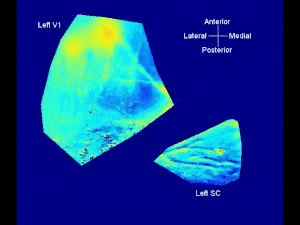
But spontaneous activity is only half of the story:
The other half comes from the fact that the circuit organizes itself depending on the activity it experiences. In machine learning, this is the "gradient descent" that wiggles the parameters of the network to improve performance. In neuroscience, it might also be gradient descent, but it can also mean the formation or removal of connections.
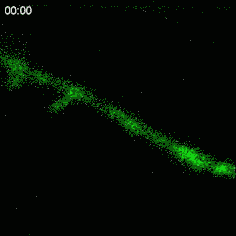
Exploring these rules for reshaping the brain is perhaps the most exciting thing we do at the lab where I do my Ph.D. The most famous principle is probably the Hebbian postulate (“Cells that fire together, wire together”), but there is a lot more nuance to be explored. Changes in the circuit depend on the exact timing of neural activity (on the scale of milliseconds), the type of cell experiencing the change, the location of the connection on the neuron, and is modulated depending on the context. But the big picture that emerges is that these changes coordinate to increase the computational capabilities, stability, and flexibility of the circuit.
Not only is the interaction between activity and plasticity goal-directed in the sense of making the circuit more capable. It is also very robust: f.e. if the animal loses an eye and thus receives less input to the brain, the brain will increase the amount of input from other sources until it again reaches the "correct" level. But what is the "correct" level? What is the goal of development?
Development might be establishing a prior for predictive processing
A particularly powerful theory of how the mind works is the “predictive processing” theory.11 In this theory, the brain is constantly generating and updating a mental model of the environment. The model is used to generate predictions of sensory input that are compared to actual sensory input. This comparison results in prediction errors that are used to update and revise the mental model. Hence, the “goal” of the brain is to arrive at a mental model that is really good at predicting sensory input. And, in this view, the “goal of development” would be to prepare the brain as well as possible for predicting future sensory input. Development establishes “prior knowledge” that is useful for understanding the world.
There is a bit of evidence for something like this. Here are some of my favorites:
“Spontaneous cortical activity reveals hallmarks of an optimal internal model of the environment”
“Retinal waves prime visual motion detection by simulating future optic flow”
“Innate Visual Learning through Spontaneous Activity Patterns”
“Slow Feature Analysis on Retinal Waves Leads to V1 Complex Cells“
This is about as far as the field has come, i.e. this is the “state of the art”. This is a bit of a shame because it is only just starting to get interesting. I have so many more questions:
What can we say about this prior?
How much/what kind of information is contained in spontaneous activity?
Is this prior “just” for sensory and motor cortices, or might it also extend to higher cortical function?
Where does the prior come from (probably evolution, but when and can we identify changes over time)?
Under which circumstances is it possible to “bootstrap” a prior in this fashion (changes in circuit → changes in activity → changes in changes in circuit → …)?
How might a developmental prior relate to large pretrained/foundational models in ML?
Can we apply some of the techniques/vocabulary from the theory of computation to this domain?
If I ever get to have my own research lab, these are questions I would love to work on.
In conclusion…
Condensed into a neat list of three points, what is my take on the development of the brain?
Brain development is a protracted process that continues well after birth.
After birth, the animal is exposed to a highly volatile environment that necessitates robust and general solutions.
The reciprocal interaction between circuit organization and activation might robustly “bootstrap” prior information into the brain.
As mentioned above, point 3 is conjecture. But I’m very excited about that conjecture and if anyone has some leads or ideas (or questions), feel free to send me an email or to book some time for a chat with me :) Looking forward to talk!
I guess that was just a long-winded way of saying: “epistemic status: I’m trying my best.”
There is a whole zoo of arguments for the possibility (and timing) of human-level artificial intelligence. Most of them have an "existence" clause like this one
[...] I focus on one particularly salient vision of a transformative model: a model that can perform a large majority of economically valuable jobs more cheaply than human workers can. I see the human brain as an “existence proof” found in nature for this type of transformative model, so I use evidence from biology to help estimate the computation needed to train it. Ajeya Cotra in the draft report on timelines to transformative AI
If we want to build (artificial) intelligence, it is reasonable to look at the (arguably) only available example of a thing that has intelligence - the brain - to get inspiration and to estimate timelines. Two interesting upper bounds jump out immediately:
the amount of compute required for training. A rough Fermi-estimate:
“Suppose it takes on average about 1 billion seconds (~32 years) for an intelligent human to go from an infant to their peak level of productivity. If a human brain performs ~1e15 FLOP/s), that would be (1e15 FLOP/s) * (1e9 seconds) = 1e24 FLOP, only about 1 OOM larger than the amount of computation used to train AlphaStar.” Ajeya Cotra in draft report on timelines to transformative AI
the size of the source code. The human genome can be encoded in ~750 megabytes of data. Since this includes a lot of junk and encodes the entire body and not just the brain, the size of the actual "source code" could be orders of magnitude smaller.
Moore's law lets us estimate how we will progress in terms of compute. But progress in terms of "source code" is much harder to estimate. The Microsoft git repository is apparently 300 gigabytes large, but of course, that's an unfair comparison. It's not about size, it's about having the right code. Looking at the development of the brain can help us to put more constraints on what an example of the right code looks like.
I know, I know justsaysinmice. I wish it was otherwise and there is a real danger of the streetlight effect.
A policeman sees a drunk man searching for something under a streetlight and asks what the drunk has lost. He says he lost his keys and they both look under the streetlight together. After a few minutes the policeman asks if he is sure he lost them here, and the drunk replies, no, and that he lost them in the park. The policeman asks why he is searching here, and the drunk replies, "this is where the light is".
But we know that some results obtained in animal models translate to humans and that this translation rate varies a lot depending on the phenomenon under investigation. And there are a few examples where theory developed for one or two animals generalizes to a much wider range of animals. So perhaps it's not so bad.
I would also, in the spirit of conceptual engineering, propose an important distinction: In my experience there are two types of researchers working on animal models:
some researchers study animal models because they are often the only thing available. Once something better becomes available, they will drop the animal model like a Totino's pizza roll that was in the microwave for too long.
other researchers really, genuinely care about that particular animal model. If it turns out that 0% of the results in that model generalize to anything else, that would only affect them in so far as they would have to come up with a different justification when writing grants.
Both types of researchers are doing valuable things, but I think it's important not to mentally lump them together since that can produce a lot of confusion in practice (i.e. when picking a lab for the Ph.D. or when motivating your research question or when explaining the impact of your research).
With “we” I mean “someone”.
Actual chip making, like molecular biology, is hard enough to effectively qualify as magic.
But often suboptimal in terms of efficiency on any given problem.
Rather than a fragile procedure with a lot of "if-then-else" clauses, I like to think of the development of the brain as a robust-agent-agnostic-process (RAAP) dead-set on producing a brain, no matter what.
One of the central truths that I learned in my studies is that "Neurons want to fire." A neuron that cannot produce action potentials will literally die. Very similar to that Keanu Reeves movie, actually.
This spontaneous activity was not visible in the clips in the section above (since there we didn't visualize the activity of the cells).
While these examples are specific to the visual cortex, spontaneous activity exists in the entire developing brain: the somatosensory cortex, the auditory cortex, the olfactory cortex, the thalamus, the hippocampus... just everywhere! And everywhere it has slightly different properties, shaped by the different neuron types in each area.
While I have peppered the previous sections with a lot of references, we are now getting into conjecture territory. “Predictive processing” is a broad field and there are a lot of different opinions represented. In particular, it is very unclear if/how the prediction error is exactly represented.


